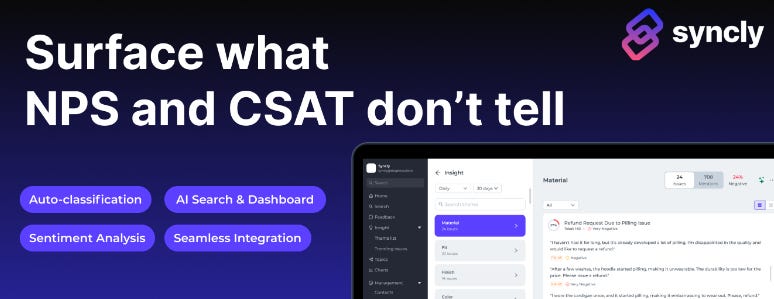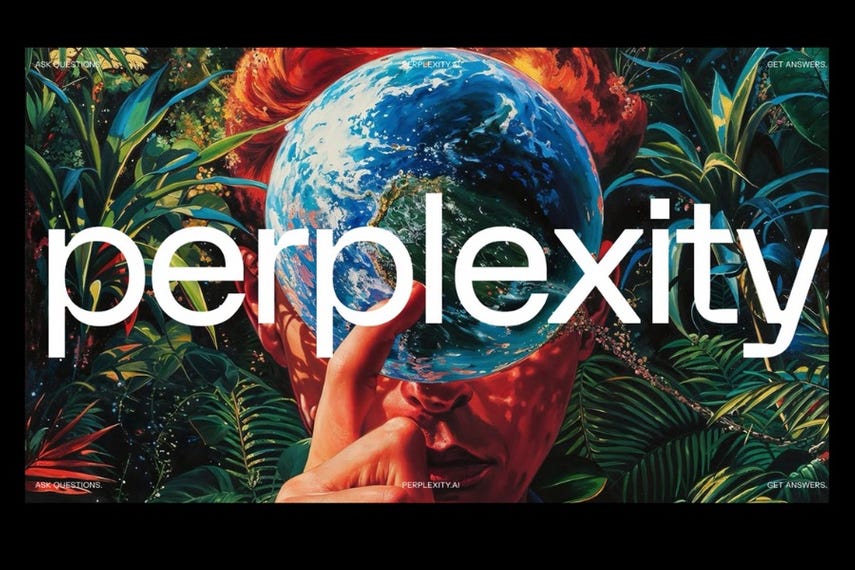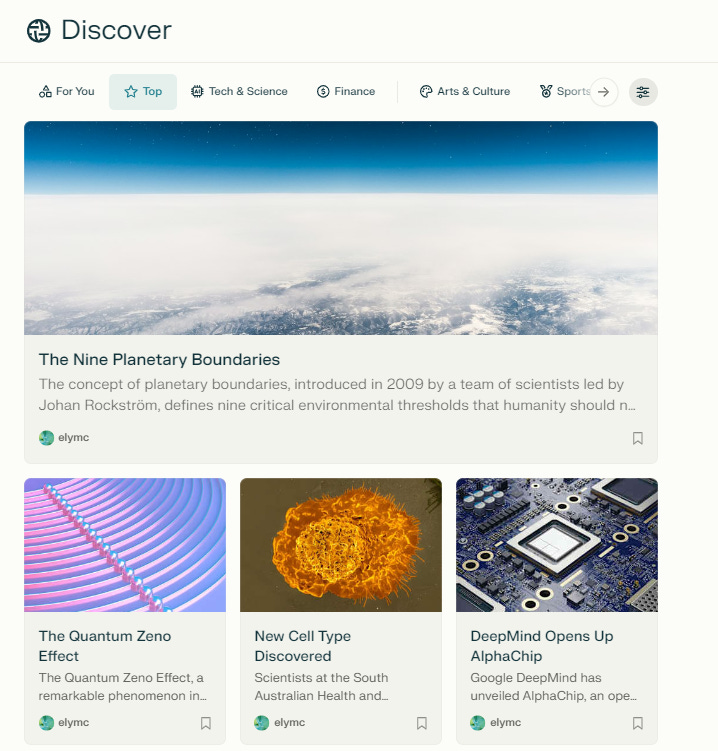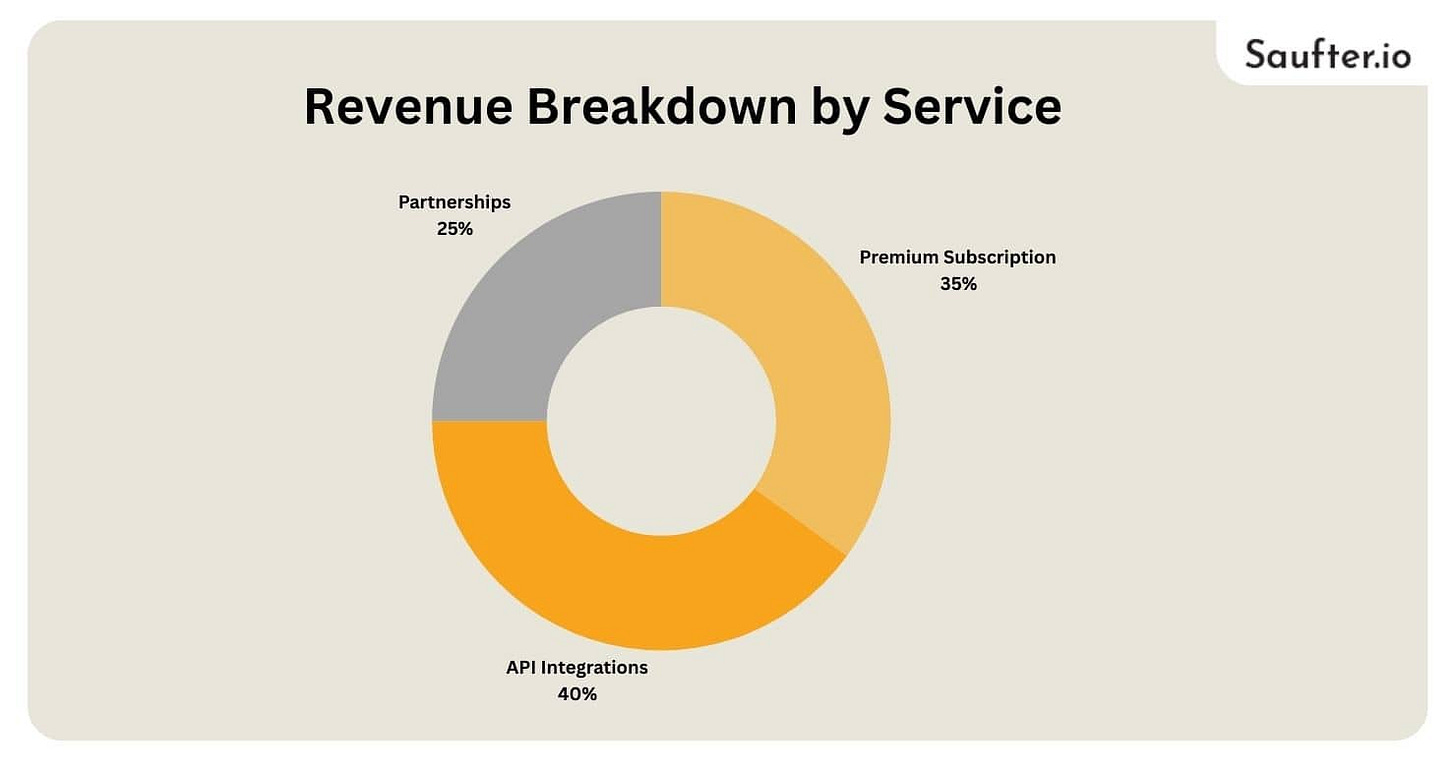🚀How Perplexity's growth is changing search habits
2,500+ words long deep dive on Perplexity story, numbers and key bets that Perplexity is taking to grow amongst its user base, publishers and brands.
Today’s newsletter edition is brough to you by Syncly.app
Get actionable insights from customer feedback, effortlessly
NPS only provides insights after the fact. Syncly (YC W23) surfaces actionable product insights from thousands of support chats, reviews, social media posts, and surveys before customers stop using your product. Syncly auto-categorizes all feedback, and reveals the underlying drivers of negative customer experience across user journey, instantly.
Productify readers get a one-week free trial.↘️↘️
It has been 6 months now since I used Google Search,
A shift that once seemed improbable. Yet, here I am, a testament to how habits can evolve.
My journey began innocently enough: I started experimenting with Perplexity.ai, asking it questions in natural language. The appeal? It provided concise to-the-point answer in one go without the need to sift through endless Google search results.
Then it came down to trust. I started noting down that perplexity wasn’t blabbering, but also giving me links to source of information and selectively only I will dive into links - but 99% of times I would be satisfied with the answer perplexity gave me.
This combination of trust, up-to-date information, and accurate responses convinced me to abandon Google Search. It's fascinating how some products can grow on you, shifting your habits without you even realizing it.
In today’s Productify edition, we delve deeper into Perplexity's strategies and metrics, we'll uncover how this innovative platform plans to challenge established players like Google and reshape the search engine landscape.
Understanding how Perplexity grows isn’t just about numbers; it’s about rethinking how we engage with information in our daily lives.
Productify Subscriber Exclusive Offer:
Get a full-day Guest Pass to Product-Led Summit in Berlin (October 16th, 2024) worth €995 for free!
But first, What is Perplexity?
Perplexity AI was founded in 2022 by Aravind Srinivas, a former research scientist at OpenAI with a PhD from UC Berkeley; Denis Yarats, an AI researcher with experience at Facebook; Johnny Ho, a former engineer at Quora; and Andy Konwinski, a co-founder of Databricks
Perplexity is an AI-powered search engine that provides answers to your questions in a conversational format, rather than just listing links like traditional search engines.
Imagine asking a question in natural language, and instead of sifting through multiple web pages, you receive a clear, concise answer that includes sources for further reading.
For example, if you ask about the best travel destinations in Europe, Perplexity will pull information from various sources, summarize it, and present it in a way that's easy to understand—all while giving credit to the original sources.
Perplexity comes with three unique features:
Real-time Search and Answer: Perplexity has the ability to crawl through multiple websites, social media, news and more to provide the most updated information on the query asked.
Source Citing: While ChatGPT and alike have been often ridiculed for hallucinations or giving wrong information often, Perplexity clearly mentions the source website from which it picked up the information to provide the most to-the-point answer to your query.
With a Pro Search, it informs its thinking process too, allowing you to know how it arrived at the answer. At the end of the answer, it also gives you follow up question for you to deep dive more into the topic.
I have really been liking the related questions section. It helps me dive deeper into the the topic I am exploring - just like how you would go into Wikipedia or YouTube spiral.
Could Perplexity utilize its ‘Related Questions’ section in some other ways? Hold this thought, we will come to it later.
As you also realize from Perplexity’s UI and UX, it is pretty clutter-free experience focusing on finding what you need rather than bombarding users with information they don’t need.
Based on your interests, it also allows you to discover more topics of interest:
How does Perplexity strategize and grow compared to traditional search engines Google and Bing?
Google’s dominance in search has been under questioning ever since tools like OpenAI, Bing with its co-pilot features and Perplexity have been on the market. One big hypothesis why this challenge is a real one for Google is because of innovator’s dilemma that often exists with big companies.
This means - does Google further accelerate its traditional ads business which is something its executives might want (their comfort zone + profitability) or disrupt their own business model by moving traffic to AI search tools that will demand new ways of user interactions and ads business (cannibalize its own traditional ads business).
It reminds me of the battle between Slack and Microsoft Teams, where Slack due to its superior experience and network effects became the tool of choice for many software companies, but eventually gets challenges by Microsoft’s distribution power. Perplexity is expected to face the same challenge.
Perplexity's primary advantage lies in its user-centric approach, which emphasizes delivering concise, direct answers rather than a list of links.
Perplexity continues to develop features like 'Your Threads' for saving search interactions and a Copilot function for suggesting follow-up questions. This personalized experience can differentiate Perplexity from traditional search engines that often overwhelm users with irrelevant ads and links.
Perplexity also plans to maintain a focus on providing high-quality, trustworthy answers sourced from reputable sites. This is crucial in an era where users are increasingly skeptical of the information they encounter online.
While monthly visits to Perplexity via Desktop and Mobile (53 Million) are tiny in comparison to Google (84.6 Billion) and Bing (3 billion) , Perplexity’s growth rate for a company that is only two years old (started in August 2022) is still marvelous.
Note that Google Search was launched 26 years back while Bing was a rebranding done 15 years back (in 2009) and it was an improvement over previous search capabilities from Microsoft.
In only two years, i.e by June 2024, Perplexity had 75M+ Monthly visitors across desktop and web and growing every month by approximately 20%.
How does Perplexity growth numbers compare to other LLM tools such as ChatGPT and Google’s Gemini?
ChatGPT focuses more on conversational interactions rather than delivering straightforward factual answers. Perplexity's emphasis on search capabilities allows it to serve users looking for quick, reliable information without engaging in lengthy dialogues.
Both Gemini and OpenAI’s SearchGPT are also entering the AI search space, but they often rely on broader indexing and may not prioritize the same level of real-time accuracy that Perplexity aims for. The real battle result is yet to be seen.
As of 2024, Perplexity has monthly active users exceeding 10 Million already. This is only 7% of the monthly active users that Google’s Gemini sees (143M).
And the monthly visits to Perplexity (via Desktop or Mobile) has been growing every month, ending up at 73 Million visits in May 2024. This is only 12% of monthly visits that ChatGPT sees every month (around 600 Million).
So while the stats of Perplexity are not as big as its nearest competitors, it boasts of many proof points for absolute product-market fit success:
On average, every user spends 11 minutes on perplexity per session
For the power users, average time spent on perplexity per session in 24 minutes - this is much higher than Google Search (average 11 minutes) and Wikipedia (3 mins)
>80% users say that Perplexity provides accurate information
85% user retention - signifying users continue to find value even after first use
Every user on average surfs 1. 8 pages of perplexity per visit signifying that users find value surfing perplexity
63% is the bounce rate (vs Google’s 28%) signifying that many users stay engaged
The market share of Perplexity currently represents the time it has been in the market as well as kind of users it attracts. Given its choice of staying accurate and recent with sources being cited, it attracts more professionals and researchers rather than general range of population like ChatGPT does. Here’s the user segment analysis:
ChatGPT has a broad audience across various demographics, primarily attracting tech-savvy individuals, students, and professionals looking for conversational AI capabilities. It also has created its niche amongst creative people. ChatGPT sends 82% of its traffic to google linked domains.
As part of Google's ecosystem, Gemini attracts a diverse audience that includes casual users, researchers, and professionals who rely on Google's extensive services. Gemini pushes 100% of traffic to its own google linked URLs.
Perplexity attracts mostly highly educated good income professionals, including researchers, writers, artists, and programmers, highlighting its versatility in addressing various content needs related to factual searches. Only sends 10% of its traffic to Google, showing that its source of information comes from various websites (news, health,research and more) and is most unbiased in general.
How does Perplexity gain traffic?
Majority of perplexity’s traffic comes from users directly coming to Perplexity followed by organic search results. Let us deep dive into all sources:
Direct Traffic (76.87%): The majority of Perplexity AI's traffic comes from users directly entering the URL or using bookmarks, indicating strong brand awareness and user loyalty.
Organic Search (12.58%): A significant portion of traffic is derived from organic search, primarily through Google. Perplexity AI's effective SEO and content marketing strategies have enabled it to rank well for relevant keywords, attracting users seeking AI-powered search solutions.
Social Media (4.23%): Platforms like Twitter, LinkedIn, and Facebook contribute to traffic through engaging content that encourages sharing. This social media presence helps Perplexity AI attract new users.
Referrals (3.87%): Referral traffic from other websites and blogs plays a crucial role in growth. Partnerships, guest posts, and media coverage have significantly boosted this channel.
Email Marketing (1.45%): Perplexity AI employs email marketing to keep users informed about new features and updates, which aids in user retention and encourages return visits.
Display Ads (0.75%) and Paid Search (0.25%): Although some investment is made in display advertising and paid search, these channels account for a minimal share of overall traffic.
How many paid subscribers Perplexity has?
In 2024 so far, Perplexity aims to reach around $40 million in revenue which will be a 67% growth rate from $24 million in revenue in 2023. Hence, Perplexity is projected to generate approximately $3.33 million per month in 2024.
If for a moment we assume that all revenues come from 20$ a month subscription for its Pro service which offers access to more advanced LLM models and also ability to generate images, we can then try to calculate its Pro user base
Number of Pro Users=Monthly Revenue from Pro Users/Price per Pro Plan
Scenario A: If 5% of users subscribe to the Pro plan:
Number of Pro Users = 5%×10,000,000=500,000
Monthly Revenue from Pro Users = 500,000×20=10,000,000 (still exceeds total revenue)
Scenario B: If 2% of users subscribe to the Pro plan:
Number of Pro Users = 2%×10,000,000=200,000
Monthly Revenue from Pro Users = 200,000×20=4,000,000 (exceeds total revenue)
Scenario C: If 1% of users subscribe to the Pro plan:
Number of Pro Users = 1%×10,000,000=100,000
Monthly Revenue from Pro Users = 100,000×20=2,000,000
Based on these scenarios:
If 1 to 2% of users subscribe to the Pro plan (100,000 users), it would generate approximately $2 million to $4 million in revenue per month.
Perplexity could have around 100,000 to possibly up to 200,000 paying subscribers for its Pro Service.
My best guess is that Perplexity has <1% of its user base using Pro since it also earns revenues from its API integrations and partnerships with publishers.
How does Perplexity earn from its API integrations and publisher partnerships?
Perplexity offers its API to developers and businesses, allowing them to integrate its AI-powered search functionalities into their applications and websites. This typically involves charging fees based on usage, which can include:
Per Query Fees: Businesses may pay for each query processed through the API.
Subscription Models: Companies might subscribe to different tiers of API access, depending on their needs for volume and features.
Perplexity has also launched a revenue-sharing initiative designed to compensate publishers when their content is referenced in search results. Key components include:
Flat Fees for Content Usage: Publishers receive a flat fee whenever their articles are used in responses that generate ad revenue for Perplexity.
Percentage of Ad Revenue: Participating publishers earn a double-digit percentage of the ad revenue generated from queries that reference their content. This incentivizes publishers to collaborate with Perplexity, as they can monetize their content more effectively.
Under the revenue-sharing program announced today, publishers will receive a flat fee when their content is used in search results that generate ad revenue for Perplexity.
The company is seeking to sign up 30 publishers to its new revenue-sharing program by 2024 end. The initial participants include Der Spiegel, Entrepreneur, Fortune, The Texas Tribune, TIME and Automattic Inc., the developer of WordPress.
An overview of Perplexity's revenue sources indicates a breakdown where premium subscriptions, API integrations, and partnerships with publishers collectively contribute to its financial success. Reports suggest that premium subscriptions account for about 35%, while API integrations and partnerships make up 40% and 25%, respectively
Perplexity’s plan to become an advertisement powerhouse (starting Q4 2024)
While it sounds like a big statement, not to be underestimated. Since we saw that power users spend >20 mins per session on Perplexity compared to Google and Bing, Perplexity can leverage this trust from users to bring out very innovative ad formats. Also, Perplexity seems to attract more-willing-to-spend professionals as compared to other platforms.
One of such innovations is that it plans to utilize additional related questions section where brands can sponsor related questions that would appear in user queries. If a user is search for a topic on ‘‘best running shoes in winter’’ and with the trust of Perplexity, sports brands can position themselves for high click rate and conversion by posting a question in related section “What is Nike’s latest innovation for winter sports wear”?
Another way Perplexity can position brands is by allowing them to buy additional branded content space along side the search results. Below is a screenshot from its pitch deck, according to which Perplexity ad strategy will be to target 15 categories, including “health, technology, finance, arts and entertainment, and food and beverage”, with advertisers able to choose to sponsor “related questions” in response to queries or run video ads in “prominent positions”.
Further, Perplexity provides a much cheaper alternative for brands to reach out to highly engaged and more premium user base of Perplexity, vs, ever increasing advertisements cost of Perplexity.
Under Perplexity’s ad system, marketers will be charged on a so-called CPM basis — paying above $50 for every 1,000 impressions generated by these sponsored posts, said a person familiar with the model. This compares with an estimated $1,100 for the same number of impressions by Google, according to analysts eMarketer.
Perplexity may offer a more cost-effective alternative for advertisers. Early adopters might benefit from lower costs and better performance metrics as Perplexity establishes its presence in the market
Perplexity has several initiatives that could contribute to additional revenue growth:
Advertising Initiatives:
By introducing targeted advertising and unique ad formats (e.g., sponsored questions, video ads), Perplexity can create new revenue streams. This could potentially add a significant percentage to their monthly revenue, depending on adoption rates by advertisers.
Subscription Model Expansion:
The introduction of a Pro Plan at $20/month allows for unlimited queries and access to premium features. If a substantial portion of the user base (currently around 10 million active users) converts to this plan, it could significantly boost monthly revenue.
For example, if just 1% (100,000 users) subscribe to the Pro Plan, that would generate an additional $2 million per month.
Revenue Sharing with Publishers:
The recently launched Publishers Program, which shares revenue with content creators, could attract more partnerships and increase traffic, leading to higher ad revenues.
Expansion into New Markets and Services:
By expanding into adjacent markets such as enterprise search solutions or browser extensions, Perplexity can capture a greater share of the overall search market, potentially increasing its user base and revenue.
Srinivas said he wanted its advertising system to become “a money-printing machine.” “A good chunk of our traffic comes from the US and other high GDP countries, making it a good experiment . . . we want to IPO and be a successful company of our own, and there is no reason not to be.”
What may lead to Perplexity’s failure?
We have talked enough about how Perplexity is growing and can make good decent money while doing so. But lets not forget it is a fish swimming in the word of sharks.
Perplexity operates in a highly competitive landscape dominated by established players like Google and emerging AI-driven platforms:
Innovation Pressure: To remain relevant, Perplexity must continuously innovate its offerings. Failure to do so could result in losing market share to competitors who provide superior services or user experiences.
Advertising Revenue Dependency: As Perplexity prepares to launch its advertising services, it faces the risk of not achieving expected ad revenues if advertisers do not find value in the platform compared to established alternatives
The success of the revenue-sharing initiative relies heavily on attracting and maintaining relationships with publishers. If major publishers opt out or demand higher shares, it could impact revenue stability .
Limited Revenue for Individual Creators: The revenue-sharing model primarily benefits media companies rather than individual content creators, which may lead to dissatisfaction and further backlash from the creative community
In my opinion, the core of growth for AI tools like Perplexity is proper attribution, otherwise it risks undermining the value of original journalism and research. This could lead to a decline in high-quality content creation, which is essential for attracting users and engagement, a must for advertisement revenues.

















where is the source of traffic comparison of chart?
Interesting thing would be to see how products like this become mainstream. A lot of Gen AI products are not allowed in financial services and education domains though Search Engines like Google and others are .
Another interesting point is that monetisation through Advertising still is the most sought after segment. We continue to compete for eyeballs and branding real-estate.